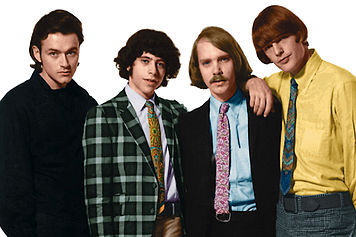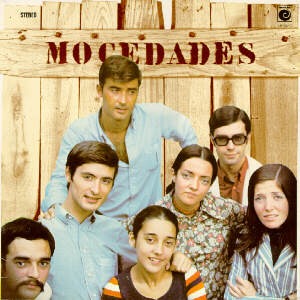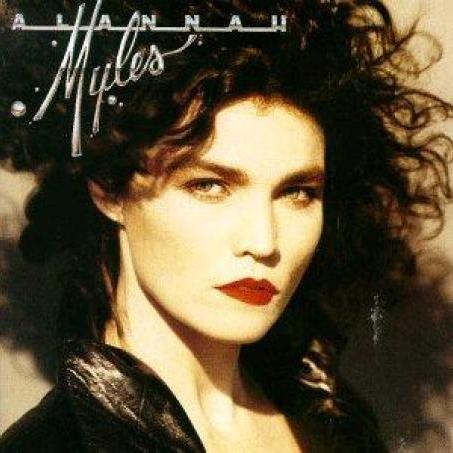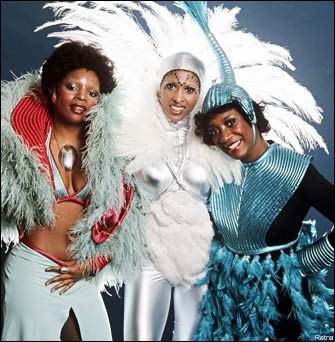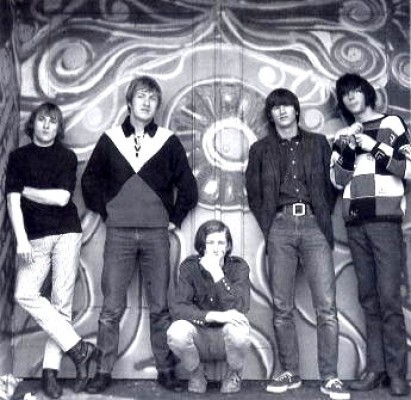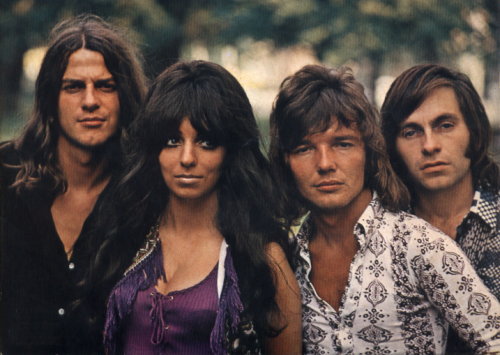1956: Andy Williams debuted on the chart with his first career single, "Walk Hand In Hand".
1956: Eydie Gorme debuted with her first career single on this date--"Too Close For Comfort".
1958: The Champs ruled the R&B chart for a fourth week with "Tequila".
1962: Mr. Acker Bilk moved to #1 on the Easy Listening chart with "Stranger On The Shore".
Another of the fun songs of the early Rock Era...
1962: Elvis Presley had his 17th #1 song, his 29th Top 10 and his 54th hit in seven years with "Good Luck Charm". Shelley Fabares slipped with "Johnny Angel" while Dee Dee Sharp edged up with "Mashed Potato Time". The Shirelles had the highest new Top 10 song, as "Soldier Boy" moved from 11-6, while Joey Dee & the Starliters were at #9 with "Shout" and Mr. Acker Bilk moved from 19 to 10 with "Stranger On The Shore".
1963: The Rolling Stones performed at the Crawdaddy Club as part of an eight-month residency at the Station Hotel in London.

1965: The Beach Boys performed "Do You Wanna' Dance?" on the ABC-TV show Shindig.
1967: The Beatles completed recording for the Sgt. Pepper's Lonely Hearts Club Band album. They recorded a short section of noise that would follow "A Day In The Life".
1969: Yes and Janis Joplin appeared at the Royal Albert Hall in London.
1970: Elton John, T. Rex and Spooky Tooth were in concert at the Roundhouse in London. It was Elton's first concert and tickets were 25 shillings, or approximately $1.25 in today's dollars.
"D'yer Maker" from Led Zep...
1973: Billion Dollar Babies by Alice Cooper moved into the #1 slot on the Album chart. The previous #1, Lady Sings the Blues by Diana Ross from the Soundtrack to the movie of the same name, fell to #2. The rest of the Top Ten: An album called The Dark Side of the Moon by Pink Floyd moved up to #3 in its third week in the Top 10, Aloha from Hawai'i via Satellite from Elvis Presley was #4, War remained at 5 with The World Is a Ghetto, The Best of Bread entered the Top 10 at #6, Masterpiece from the Temptations was at #7, Elton John slipped to #8 after a long run in the upper part of the list with Don't Shoot Me I'm Only the Piano Player, Dueling Banjos from Eric Weissberg & Steve Mandell was #9 and Houses of the Holy climbed from 85 to 10 for Led Zeppelin.
1973: "Tie a Yellow Ribbon Round The Ole Oak Tree", the true story of a prisoner writing to his girlfriend, reached #1 for Dawn featuring Tony Orlando. War closed to #2 with "The Cisco Kid" but that was as high as they would get. The rest of the Top 10: "Sing" from the Carpenters, Vicki Lawrence fell with the former #1 "The Night The Lights Went Out In Georgia", Sweet had their first hit "Little Willy" at #5, Stevie Wonder was shooting up the charts with "You Are The Sunshine Of My Life" at #6, the Temptations were at 7 with "Masterpiece", Donny Osmond reached #8 with "The Twelfth of Never", Stealers Wheel owned #9 with "Stuck In The Middle With You" and the Four Tops completed the list with "Ain't No Woman (Like the One I've Got)".
1977: Jesse Winchester performed in the U.S. for the first time in 10 years (at Burlington, Vermont), after moving to Canada to avoid the draft.
1977: John Denver and Natalie Cole were guests on the ABC-TV show Frank Sinatra & Friends.

1978: Sandy Denny, a member of Fairport Convention and a solo performer as well, died at the age of 31 in Wimbledon, London, England, the result of a traumatic mid-brain hemorrhage. Denny had fallen down a staircase at her parents' home in Cornwall, England and a month later, collapsed at a friend's home. She died four days later. Denny sang on the track "Battle Of Evermore" on the album Led Zeppelin IV.
1979: Amii Stewart had a #1 record with "Knock On Wood" while Gloria Gaynor held at #2 with her former #1 "I Will Survive". Blondie moved from 8 to 3 with "Heart Of Glass" and Frank Mills reached #4 with "Music Box Dancer". The Doobie Brothers fell from the top spot to #5 with "What A Fool Believes". The rest of the Top 10: Peaches & Herb had #6 with "Reunited", Suzi Quatro teamed with Chris Norman for the #7 song "Stumblin' In", the Bee Gees were at 8 with their former #1 "Tragedy", Chic moved into the Top 10 with "I Want Your Love" and Dire Straits found themselves at #10 with "Sultans Of Swing".
"Water of Love" from the hot new group Dire Straits...
1979: Spirits Having Flown, the best studio album the Bee Gees ever put out, reached #1 on the Album chart, taking the place of the Doobie Brothers' Minute by Minute. Dire Straits' dazzling debut was at #3 with 2 Hot! by Peaches & Herb at #4. The remainder of the Top 10: Blondes Have More Fun from Rod Stewart, Desolation Angels by Bad Company at #6, Livin' Inside Your Love from George Benson edged up to #7, Blondie had their first Top 10 album with Parallel Lines, Enlightened Rouges from the Allman Brothers Band was at 9 and Love Tracks by Gloria Gaynor fell to #10.
1979: "Crazy Love" spent a seventh week at #1 for Poco on the Adult Contemporary chart.
1980: Pete Townshend released his very good solo album Empty Glass. (Note: several websites claim the album was released April 14, but 'MTV' pegs the date as April 21.)
1982: Clash leader Joe Strummer disappeared for three weeks before finally turning up in Paris, France, just getting away from it all. Strummer's actions forced the group to cancel a tour.
Annie and Dave with another Top 10...
1984: Phil Collins had his inaugural #1 with "Against All Odds" with the former #1 "Footloose" falling for Kenny Loggins. Lionel Richie had a huge hit with "Hello" which was #3 on this date. The rest of the Top 10: "Hold Me Now" from the Thompson Twins, "Miss Me Blind" by Culture Club at #5, the Pointer Sisters down to 6 with "Automatic", Rockwell was at 7 with "Somebody's Watching Me", song #8 was a good mover for Rick Springfield, the rocker "Love Somebody", the Eurythmics had #9 with "Here Comes The Rain Again" and Tracey Ullman had a Top 10 song with "They Don't Know".
1984: "Hello" by Lionel Richie spent a third consecutive week at #1 on the Adult Contemporary chart.

1984: The album that very likely could be one of The Top Soundtracks of the Rock Era* was Footloose, and it reached #1 on the Album chart on this date, besting the Michael Jackson album Thriller which fell to #3. The move ended Thriller's run of 37 non-consecutive weeks at #1. 1984 from Van Halen was at #2 and Can't Slow Down, the second album from Lionel Richie, was #4. The rest of the Top 10: The great album Sports by Huey Lewis & the News, Colour By Numbers from the Culture Club was #6, Touch by the Eurythmics was at 7, the Scorpions had the #8 album with Love At First Sting, the Cars were back in a big way with Heartbeat City at #9 and Cyndi Lauper held on to #10 with She's So Unusual.
1990: Amy Grant brought a law suit against Marvel Comics for including a likeness of her in a Dr. Strange comic.
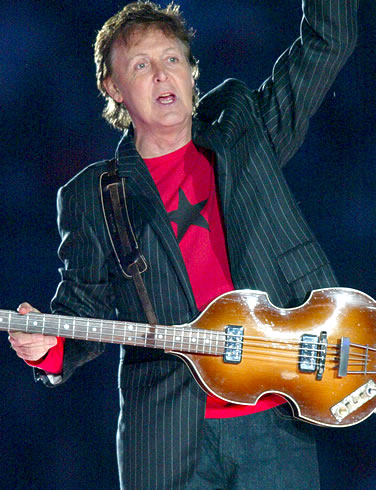
McCartney was still setting records...
1990: Paul McCartney set a new world record when he played for 184,000 fans at the Maracana Stadium in Rio de Janeiro, the largest crowd to ever attend a paid rock concert. Of course, over 600,000 saw Simon & Garfunkel in a free concert in New York City's Central Park in 1981.
1990: Fleetwood Mac posted another U.K. #1 album with Behind the Mask.
"Thing Called Love", from the album of Bonnie's career...
1990: Bonnie Raitt remained at #1 on the Album chart for the third week in a row with Nick Of Time. Sinead O'Connor was at #2 with I Do Not Want What I Haven't Got and Janet Jackson's Rhythm Nation 1814 edged up to #3. The rest of the Top 10: The former #1 Forever Your Girl by Paula Abdul, Soul Provider by Michael Bolton was #5, Alannah Myles' debut was at #6, Please Hammer Don't Hurt 'Em from M.C. Hammer moved up to #7, Aerosmith remained at #8 with Pump, Phil Collins was at 9 with his album ...But Seriously and Depeche Mode moved into the Top 10 with Violator.

O'Connor had a huge worldwide hit...
1990: "Nothing Compares To You" reached #1 for Sinead O'Connor; it was also #1 in 18 other countries. Jane Child remained at 2 with "Don't Wanna' Fall In Love", Lisa Stansfield was at #3, Calloway had #4 with "I Wanna' Be Rich" and Tommy Page's former #1 "I'll Be Your Everything" was down to #5.
1990: "This Old Heart Of Mine" by Rod Stewart and Ronald Isley took over the #1 spot on the Adult Contemporary chart.
1993: Former Rolling Stone member Bill Wyman entered his third marriage, marrying 33-year old Suzanne Accosta in Saint-Paul-de-Vence, France.
1993: Drummer Bill Kreutzmann of the Grateful Dead saved the life of a young surfer from a riptide in the Pacific Ocean near Mendocino, California.
2000: Neal Matthews of Elvis Presley's vocal supporting group the Jordanaires died of a heart attack in Brentwood, Tennessee at age 70. Matthews, who sang on "Don't Be Cruel" and Hound Dog", among others, also sang for Ricky Nelson, Patsy Cline, Johnny Horton, Marie Osmond and Tom Jones.

2002: Oasis reached #1 for the sixth time in the U.K. with "Hindu Times".
2004: In today's episode of Dangerous Inmates Run Rap Music, Rapper T.I. was sentenced to three years in jail. And now back to music.
2004: Gary Barlow of Take That ("Back For Good") announced that the group would get back together for one show at Christmas.

2008: Al Wilson ("Show And Tell") died at the age of 68 of kidney failure in Fontana, California.
2011: Joe Pennell, lead guitarist of the Rivieras ("California Sun") died at the age of 66.
Born This Day:
1947: John Weider, bassist of the Animals, was born in London. (Note: some websites insist on reporting that Weider was born in Shepherd's Bush, London, England. Shepherd's Bush is an area, not a city, and Shepherd's Bush will never be shown on an official birth certificate. Weider was born in London.)
1947: Alan Wagner of the Foundations ("Build Me Up Buttercup")
1947: Iggy Pop was born in Muskegon, Michigan.

1948: Paul Davis was born in Meridian, Mississippi; died of a heart attack in his hometown April 22, 2008.
1951: Nicole Barclay of Fanny ("Butter Boy")
1958: Mike Barson, founding member and keyboardist with Madness ("Our House"), was born in Edinburgh, Scotland. (Note: some websites claim that Barson was born on May 21, but he was born April 21, according to the books 'Ska: An Oral History' by Heather Augustyn and 'House of Fun: The Story of Madness' by John Reed.) 1959: Robert Smith, vocalist and guitarist for the Cure, was born in Blackpool, Lancashire, England. (Note: some websites claim Smith was born in Sussex. Blackpool is in the county of Lancashire, not Sussex.)
1963: Johnny McElhone, songwriter and guitarist of Altered Images and Texas, was born in Bearsden, Scotland. (Note: some websites report McElhone was born in Lanarkshire, Scotland, or Bearsden, Scotland. According to 'Billboard' magazine, Johnny was born in Glasgow.)
1956: Eydie Gorme debuted with her first career single on this date--"Too Close For Comfort".
1958: The Champs ruled the R&B chart for a fourth week with "Tequila".
1962: Mr. Acker Bilk moved to #1 on the Easy Listening chart with "Stranger On The Shore".
Another of the fun songs of the early Rock Era...
1962: Elvis Presley had his 17th #1 song, his 29th Top 10 and his 54th hit in seven years with "Good Luck Charm". Shelley Fabares slipped with "Johnny Angel" while Dee Dee Sharp edged up with "Mashed Potato Time". The Shirelles had the highest new Top 10 song, as "Soldier Boy" moved from 11-6, while Joey Dee & the Starliters were at #9 with "Shout" and Mr. Acker Bilk moved from 19 to 10 with "Stranger On The Shore".
1963: The Rolling Stones performed at the Crawdaddy Club as part of an eight-month residency at the Station Hotel in London.

1965: The Beach Boys performed "Do You Wanna' Dance?" on the ABC-TV show Shindig.
1967: The Beatles completed recording for the Sgt. Pepper's Lonely Hearts Club Band album. They recorded a short section of noise that would follow "A Day In The Life".
1969: Yes and Janis Joplin appeared at the Royal Albert Hall in London.
1970: Elton John, T. Rex and Spooky Tooth were in concert at the Roundhouse in London. It was Elton's first concert and tickets were 25 shillings, or approximately $1.25 in today's dollars.
"D'yer Maker" from Led Zep...
1973: Billion Dollar Babies by Alice Cooper moved into the #1 slot on the Album chart. The previous #1, Lady Sings the Blues by Diana Ross from the Soundtrack to the movie of the same name, fell to #2. The rest of the Top Ten: An album called The Dark Side of the Moon by Pink Floyd moved up to #3 in its third week in the Top 10, Aloha from Hawai'i via Satellite from Elvis Presley was #4, War remained at 5 with The World Is a Ghetto, The Best of Bread entered the Top 10 at #6, Masterpiece from the Temptations was at #7, Elton John slipped to #8 after a long run in the upper part of the list with Don't Shoot Me I'm Only the Piano Player, Dueling Banjos from Eric Weissberg & Steve Mandell was #9 and Houses of the Holy climbed from 85 to 10 for Led Zeppelin.
1973: "Tie a Yellow Ribbon Round The Ole Oak Tree", the true story of a prisoner writing to his girlfriend, reached #1 for Dawn featuring Tony Orlando. War closed to #2 with "The Cisco Kid" but that was as high as they would get. The rest of the Top 10: "Sing" from the Carpenters, Vicki Lawrence fell with the former #1 "The Night The Lights Went Out In Georgia", Sweet had their first hit "Little Willy" at #5, Stevie Wonder was shooting up the charts with "You Are The Sunshine Of My Life" at #6, the Temptations were at 7 with "Masterpiece", Donny Osmond reached #8 with "The Twelfth of Never", Stealers Wheel owned #9 with "Stuck In The Middle With You" and the Four Tops completed the list with "Ain't No Woman (Like the One I've Got)".
1977: Jesse Winchester performed in the U.S. for the first time in 10 years (at Burlington, Vermont), after moving to Canada to avoid the draft.
1977: John Denver and Natalie Cole were guests on the ABC-TV show Frank Sinatra & Friends.

1978: Sandy Denny, a member of Fairport Convention and a solo performer as well, died at the age of 31 in Wimbledon, London, England, the result of a traumatic mid-brain hemorrhage. Denny had fallen down a staircase at her parents' home in Cornwall, England and a month later, collapsed at a friend's home. She died four days later. Denny sang on the track "Battle Of Evermore" on the album Led Zeppelin IV.
1979: Amii Stewart had a #1 record with "Knock On Wood" while Gloria Gaynor held at #2 with her former #1 "I Will Survive". Blondie moved from 8 to 3 with "Heart Of Glass" and Frank Mills reached #4 with "Music Box Dancer". The Doobie Brothers fell from the top spot to #5 with "What A Fool Believes". The rest of the Top 10: Peaches & Herb had #6 with "Reunited", Suzi Quatro teamed with Chris Norman for the #7 song "Stumblin' In", the Bee Gees were at 8 with their former #1 "Tragedy", Chic moved into the Top 10 with "I Want Your Love" and Dire Straits found themselves at #10 with "Sultans Of Swing".
"Water of Love" from the hot new group Dire Straits...
1979: Spirits Having Flown, the best studio album the Bee Gees ever put out, reached #1 on the Album chart, taking the place of the Doobie Brothers' Minute by Minute. Dire Straits' dazzling debut was at #3 with 2 Hot! by Peaches & Herb at #4. The remainder of the Top 10: Blondes Have More Fun from Rod Stewart, Desolation Angels by Bad Company at #6, Livin' Inside Your Love from George Benson edged up to #7, Blondie had their first Top 10 album with Parallel Lines, Enlightened Rouges from the Allman Brothers Band was at 9 and Love Tracks by Gloria Gaynor fell to #10.
1979: "Crazy Love" spent a seventh week at #1 for Poco on the Adult Contemporary chart.
1980: Pete Townshend released his very good solo album Empty Glass. (Note: several websites claim the album was released April 14, but 'MTV' pegs the date as April 21.)
1982: Clash leader Joe Strummer disappeared for three weeks before finally turning up in Paris, France, just getting away from it all. Strummer's actions forced the group to cancel a tour.
Annie and Dave with another Top 10...
1984: Phil Collins had his inaugural #1 with "Against All Odds" with the former #1 "Footloose" falling for Kenny Loggins. Lionel Richie had a huge hit with "Hello" which was #3 on this date. The rest of the Top 10: "Hold Me Now" from the Thompson Twins, "Miss Me Blind" by Culture Club at #5, the Pointer Sisters down to 6 with "Automatic", Rockwell was at 7 with "Somebody's Watching Me", song #8 was a good mover for Rick Springfield, the rocker "Love Somebody", the Eurythmics had #9 with "Here Comes The Rain Again" and Tracey Ullman had a Top 10 song with "They Don't Know".
1984: "Hello" by Lionel Richie spent a third consecutive week at #1 on the Adult Contemporary chart.

1984: The album that very likely could be one of The Top Soundtracks of the Rock Era* was Footloose, and it reached #1 on the Album chart on this date, besting the Michael Jackson album Thriller which fell to #3. The move ended Thriller's run of 37 non-consecutive weeks at #1. 1984 from Van Halen was at #2 and Can't Slow Down, the second album from Lionel Richie, was #4. The rest of the Top 10: The great album Sports by Huey Lewis & the News, Colour By Numbers from the Culture Club was #6, Touch by the Eurythmics was at 7, the Scorpions had the #8 album with Love At First Sting, the Cars were back in a big way with Heartbeat City at #9 and Cyndi Lauper held on to #10 with She's So Unusual.
1990: Amy Grant brought a law suit against Marvel Comics for including a likeness of her in a Dr. Strange comic.

McCartney was still setting records...
1990: Paul McCartney set a new world record when he played for 184,000 fans at the Maracana Stadium in Rio de Janeiro, the largest crowd to ever attend a paid rock concert. Of course, over 600,000 saw Simon & Garfunkel in a free concert in New York City's Central Park in 1981.
1990: Fleetwood Mac posted another U.K. #1 album with Behind the Mask.
"Thing Called Love", from the album of Bonnie's career...
1990: Bonnie Raitt remained at #1 on the Album chart for the third week in a row with Nick Of Time. Sinead O'Connor was at #2 with I Do Not Want What I Haven't Got and Janet Jackson's Rhythm Nation 1814 edged up to #3. The rest of the Top 10: The former #1 Forever Your Girl by Paula Abdul, Soul Provider by Michael Bolton was #5, Alannah Myles' debut was at #6, Please Hammer Don't Hurt 'Em from M.C. Hammer moved up to #7, Aerosmith remained at #8 with Pump, Phil Collins was at 9 with his album ...But Seriously and Depeche Mode moved into the Top 10 with Violator.

O'Connor had a huge worldwide hit...
1990: "Nothing Compares To You" reached #1 for Sinead O'Connor; it was also #1 in 18 other countries. Jane Child remained at 2 with "Don't Wanna' Fall In Love", Lisa Stansfield was at #3, Calloway had #4 with "I Wanna' Be Rich" and Tommy Page's former #1 "I'll Be Your Everything" was down to #5.
1990: "This Old Heart Of Mine" by Rod Stewart and Ronald Isley took over the #1 spot on the Adult Contemporary chart.
1993: Former Rolling Stone member Bill Wyman entered his third marriage, marrying 33-year old Suzanne Accosta in Saint-Paul-de-Vence, France.
1993: Drummer Bill Kreutzmann of the Grateful Dead saved the life of a young surfer from a riptide in the Pacific Ocean near Mendocino, California.
2000: Neal Matthews of Elvis Presley's vocal supporting group the Jordanaires died of a heart attack in Brentwood, Tennessee at age 70. Matthews, who sang on "Don't Be Cruel" and Hound Dog", among others, also sang for Ricky Nelson, Patsy Cline, Johnny Horton, Marie Osmond and Tom Jones.

2002: Oasis reached #1 for the sixth time in the U.K. with "Hindu Times".
2004: In today's episode of Dangerous Inmates Run Rap Music, Rapper T.I. was sentenced to three years in jail. And now back to music.
2004: Gary Barlow of Take That ("Back For Good") announced that the group would get back together for one show at Christmas.

2008: Al Wilson ("Show And Tell") died at the age of 68 of kidney failure in Fontana, California.
2011: Joe Pennell, lead guitarist of the Rivieras ("California Sun") died at the age of 66.
Born This Day:
1947: John Weider, bassist of the Animals, was born in London. (Note: some websites insist on reporting that Weider was born in Shepherd's Bush, London, England. Shepherd's Bush is an area, not a city, and Shepherd's Bush will never be shown on an official birth certificate. Weider was born in London.)
1947: Alan Wagner of the Foundations ("Build Me Up Buttercup")
1947: Iggy Pop was born in Muskegon, Michigan.

1948: Paul Davis was born in Meridian, Mississippi; died of a heart attack in his hometown April 22, 2008.
1951: Nicole Barclay of Fanny ("Butter Boy")
1958: Mike Barson, founding member and keyboardist with Madness ("Our House"), was born in Edinburgh, Scotland. (Note: some websites claim that Barson was born on May 21, but he was born April 21, according to the books 'Ska: An Oral History' by Heather Augustyn and 'House of Fun: The Story of Madness' by John Reed.) 1959: Robert Smith, vocalist and guitarist for the Cure, was born in Blackpool, Lancashire, England. (Note: some websites claim Smith was born in Sussex. Blackpool is in the county of Lancashire, not Sussex.)
1963: Johnny McElhone, songwriter and guitarist of Altered Images and Texas, was born in Bearsden, Scotland. (Note: some websites report McElhone was born in Lanarkshire, Scotland, or Bearsden, Scotland. According to 'Billboard' magazine, Johnny was born in Glasgow.)

